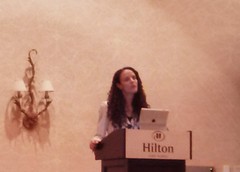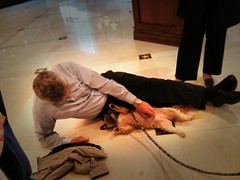
Speaker: Jenica Rogers, SUNY Potsdam
She is speaking from the perspective of the librarian. Resources are information, relationships, and identity. Money and human resources are outside of the scope of any speaker, but they follow on to successfully building the other three. If we had all that we needed, decisions wouldn’t be hard. It’s the scarcity that makes them challenging. She will talk about mitigating that scarcity.
The big deals gave us the sense that we can have everything, but the bubble is bursting for most of us. Librarians have to find a way to make change in an environment where everyone else likes the status quo.
“I could never do what you did.” She hears that a lot about many things she’s done, from moving away from ACS bundled purchases to demanding clarity in pricing to licensing terms. She doesn’t think they mean they don’t want to do it, but that they aren’t able to do that. “We can’t rock the boat too much.”
This might be true, but it’s unfair to say “I could never do that.” They could if they want to, but they have to lay the groundwork.
When she first started as a librarian, she was the liaison to the sciences. She asked why their journals cost so much and why they needed them, and they were helpful in providing data and reasons. It made sense for that organization, so she didn’t seek change.
She did the same investigation at her current organization. She saw a need to do some hard things, but her role as collection development librarian didn’t give her the mandate to build the relationships needed.
The first thing we need to do to move beyond just doing the tasks to strategic stuff is to build a framework of what we do and why we do it. We need to know the context we exist in, through awareness of the profession and business at large, publishing cycles and trends, faculty tenure, course deliver, institutional goals, etc. Some frameworks to consider: HEPI 2.1% overall and 8.1% for supplies and materials, research data curation mandates, and Ithaka comparison data.
The second piece is personal. You have to know yourself to be someone to make hard decisions and move forward with confidence in the work you do. Do you know your goals, strengths, and weaknesses? Change starts with you. It’s easy to keep doing what we’re doing. It’s satisfying to do your job very well, but do you know why you do it? Do you know where you fit into the bigger picture?
Your personal capital is based on your reputation and identity. You can burn your capital because you have acquired it through personality and what you’ve done. You need to build that capital in order to make changes. It doesn’t matter why you have your reputation, or what it is, because it’s what you do to get by.
Be the expert on your problem. Gather the data and evidence. Building your capital can be easier if you have the data or expertise to back that up. Sometimes the facts can shout when you can only whisper. Consider gathering data because it’s a communication tool.
Make friends. Ask people about themselves. They like it. It’s an icebreaker that works in every social and professional setting to help you connect with people. If you need to know who to go to when you need help/feedback/support.
Start now. There is no such thing as too early, but too late is real. “I couldn’t do that” really is “I couldn’t do that right now.” All the things you need to do to this you have to acquire/develop before the moment of need. Start gathering the resources immediately so when you reach that point of need, you have something to draw on.
Find common ground. Where do your issues touch your allies’ issues? Every scholar has a different need or approach to their work and resources. If you want to talk to a group knowing they have all those different needs, then you need to find the common ground and link that to the things that matter to you. Your network of allies can be connected far more than you think.
Communicate effectively. We librarians are great at many things, but we are not so good about talking about the things we love to people who don’t love it. Sometimes we need to know when to go for a hard sell or just coffee. Spreadsheets with pie charts might work with one person, but a story is better with another. Casual email vs. letterhead. Do it yourself or delegate. Messages can get lost if the medium and message are out of sync. Consider how you are communicating your message — will it resonate with your audience?
The only thing you can control is yourself. That said, sometimes you have to be reactive. Be prepared to be surprised and respond well.
The time has come for us to consider evolving. The information economy is changing, so we have to do that, too. It will be based on local needs/climate, but there will be change. To do this we need a constant network of support. People who supported us in the print world may not want to support us in this new way, but there are others who will. There are new partners and allies if we go looking for them.
Release fear. Fear makes you defensive. Fear does not make strong partnerships. Fear does not make smart decisions. Fear makes safe decisions.
There are no easy choices, but it’s almost always worth it. In a world of scarcity, it’s never going to get easier. Anyone can do whatever they need to do when faced with a hard decision if they have done the work to build that safety net.






